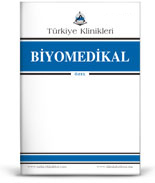Oxidative stress is a major and recurrent cause of inflammation in organ transplantation. The ischemia-reperfusion damage that occurs during organ transplantations causes emergence of free oxygen radicals and pathological nitrogen products. This increases oxidative stress. Reducing oxidative stress leads to increased consumption of endogenous antioxidants. Depending on the degree of oxidative stress, various degrees of damage may occur in the transplanted organ, and as a result, the function of the graft may be impaired. The decrease in adenosine triphosphate (ATP) level formed during ischemia leads to acidification in the intracellular and extracellular environment. This results in accumulation of sodium and calcium in the intracellular environment. Calcium ion accumulation leads to activation of calcium-dependent proteases, which initiates irreversible cell membrane damage that causes necrosis, apoptosis, and autophagic mechanisms. Especially increase in superoxide radicals and proinflammatory factors, decrease in nitric oxide production and activation of hypoxatine-xanthine oxidase system in the liver increase hepatocellular damage by increasing oxidative stress. While ischemia creates serious tissue damage, reperfusion of the organ can lead to more severe damage. The increase in oxygen levels with reperfusion may contribute to the increase of reactive oxygen products. It has been shown that the main cells that initiate ischemia-reperfusion injury in the liver are Kupfer Cells, and the main mediators are reactive oxygen and reactive nitrogen products. Reactive oxygen products include hydrogen peroxide (H2O2), superoxide anion and hydroxyl radicals. The most biologically relevant reactive nitrogen product is nitric oxide (NO). Activation of Kupfer Cells together with reactive oxygen products causes formation of tumor necrosis factor-alpha (TNF-alpha) and interleukin-1 (IL-1). DNA damage and endothelial dysfunction may also occur during ischemia-reperfusion injury. There is no proven treatment to prevent ischemia-reperfusion injury during reperfusion, other than ischemic preconditioning. During reperfusion, Kupfer Cells stimulate the secretion of CD4+ T lymphocytes; proinflammatory cytokines such as TNF-alpha and IL-1 are activated. Anti-inflammatory cytokines such as IL-4 and IL-10 also work to reduce ischemia-reperfusion injury. Meanwhile, there is a decrease in the levels of many antioxidants. In the late phase of reperfusion, reactive oxygen products and proinflammatory mediators can activate sinusoidal endothelial and CD4+ T cells, and they attract neutrophils to the injury site. Intercellular adhesion molecule-1 (ICAM-1) and vascular cell adhesion molecules (VCM-1) secreted by endothelial cells increase neutrophil infiltration. Activation of innate immune responses is observed during ischemia-reperfusion injury. As a result, reactive oxygen products from damaged cells and damage associated molecular patterns (DAMP) such as high mobility group box-1 (HMGB-1) and heat shock proteins (HSPs) emerge. These are recognized by Toll-like receptors (TLRs). Activation of signal transduction proteins and transcription factors by TLRs results in the production and release of inflammatory cytokines and chemokines that enhance dendritic cell maturation. N-acetyl cysteine is beneficial in many stages in reducing ischemia-reperfusion injury. In addition, to reduce inflammation in the graft; antiischemic interventions, therapies targeting TLRs and Nuclear factor KappaB, therapies that reduce inflammatory cytokines and adhesion molecules, complement inhibition and antiapoptotic strategies can be used. Transplanted tissues can be rejected as hyperacute, acute and chronic. The most important mechanism in the prevention of rejections is immunosuppression treatments that prevent the activation and functions of T cells.
Keywords: Inflammation; organ transplantation; ischemia-reperfusion injury
Organ transplantasyonunda oksidatif stres, inflamasyona neden olan majör ve tekrarlayan bir nedendir. Organ transplantasyonları sırasında oluşan iskemi-reperfüzyon hasarı serbest oksijen radikalleri ve patolojik nitrojen ürünlerinin ortaya çıkmasına neden olur ve bu durum oksidatif stresi arttırır. Oksidatif stresi azaltmak için endojen antioksidan tüketiminde artma olur. Oluşan oksidatif stresin derecesiyle orantılı olarak transplante edilen organda değişik derecelerde hasar oluşabilir ve bunun sonucu olarak graftın işlevlerinde bozulma görülebilir. İskemi sırasında oluşan adenozin trifosfat (ATP) düzeyinde azalma intrasellüler ve ekstrasellüler ortamda asidifikasyona yol açar. Bu durumda intrasellüler ortamda sodyum ve kalsiyum birikimine neden olur. Kalsiyum iyonu birikimi, kalsiyum bağımlı proteazların aktivasyonuna yol açarak nekroz, apoptoz ve otofajik mekanizmaların oluşmasına neden olan geri dönüşümü olmayan hücre membran hasarını başlatır. Özellikle karaciğerde süperoksit radikalleri ve proinflamatuvar faktörlerde artma, nitrik oksit üretiminde azalma ve hipoksatin-ksantin oksidaz sisteminde aktivasyon oksidatif stresi yükselterek hepatosellüler hasarı arttırır. İskemi ciddi bir doku hasarı oluştururken, organın reperfüzyonu daha şiddetli bir hasarlanmaya yol açabilir. Reperfüzyonla birlikte oksijen düzeylerindeki artma reaktif oksijen ürünlerinin artmasına katkı sağlayabilir. Karaciğerde iskemi reperüzyon hasarını başlatan ana hücrelerin Kuppfer Hücreleri, ana mediatörlerin de reaktif oksijen ve reaktif nitrojen ürünleri olduğu gösterilmiştir. Reaktif oksijen ürünleri; hidrojen peroksit(H2O2), süperoksit anyonu ve hidroksil radikallerini içerir. Biyolojik olarak en alakalı reaktif nitrojen ürünü ise nitrik oksittir (NO). Reaktif oksijen ürünleri ile birlikte Kuppfer Hücreleri'nin aktivasyonu, tümör nekroz faktör-alfa (TNF-alfa) ve interlökin-1 (IL-1) oluşmasına neden olur. İskemi-reperfüzyon hasarı sırasında DNA hasarı ve endotel disfonksiyonu da ortaya çıkabilir. Reperfüzyon sırasında, iskemik ön koşullandırma dışında iskemi-reperfüzyon hasarını önlemek için etkinliği kanıtlanmış bir tedavi bulunmamaktadır. Reperfüzyon sırasında Kuppfer Hücreleri tarafından aktive edilen CD4+ T lenfositlerin salgılanmasını uyardığı TNF-alfa ve IL-1 gibi proinflamatuvar sitokinler aktive olurken; IL-4 ve IL-10 gibi antiinflamatuvar sitokinler de iskemi-reperfüzyon hasarının azaltılmasını sağlamaya çalışır. Bu sırada birçok antioksidan düzeyinde azalma görülür. Reperfüzyonun geç fazında reaktif oksijen ürünleri ve proinflamatuar mediatörler, sinüzoidal endotel ve CD4+ T hücreleri hücrelerini aktive edebilir ve nötrofillerin hasar alanına çekilmesine neden olur. Endotel hücreleri tarafından salgılanan intersellüler adezyon molekül-1(ICAM-1) ve vasküler hücre adezyon molekülleri (VCM-1) nötrofil infiltrasyonunu arttırır. İskemi-reperfüzyon hasarı sırasında doğuştan gelen (innate) immün yanıtlarda aktivasyon görülür. Bunun sonucunda hasarlı hücrelerden reaktif oksijen ürünleri ve sonrasında yüksek mobilite grubu box-1 (HMGB-1) ve ısı şoku proteinler (HSP'ler) gibi damage associated molecular patterns (DAMP) ortaya çıkar. Bunlar Toll-like reseptörler (TLR'ler) tarafından tanınır. TLR'ler tarafından sinyal transdüksiyon proteinlerini ve transkripsiyon faktörlerini aktive edilmesi, dendritik hücre olgunlaşmasını güçlendiren inflamatuar sitokinlerin ve kemokinlerin üretimi ve salınımı ile sonuçlanır. İskemi reperfüzyon hasarını azaltmada N-asetil sistein birçok aşamada yararlı olmaktadır. Ayrıca grafttaki inflamasyonu azaltmak için; antiiskemik girişimler, TLR'leri ve Nükleer faktör KappaB'yi hedefleyen tedaviler, inflamatuvar sitokin ve adhezyon moleküllerini azaltmayı sağlayan tedaviler, kompleman inhibisyonu ve antiapoptotik stratetejiler kullanılabilir. Transplante dokular, hiperakut, akut ve kronik olarak reddedilebilmektedir. Rejeksiyonların önlenmesinde en önemli mekanizma T hücre aktivasyon ve işlevlerinin engellenmesini sağlayan immünsupresyon tedavileridir.
Anahtar Kelimeler: Inflamasyon; organ transplantasyonu; iskemi-reperfüzyon hasarı







.: İşlem Listesi